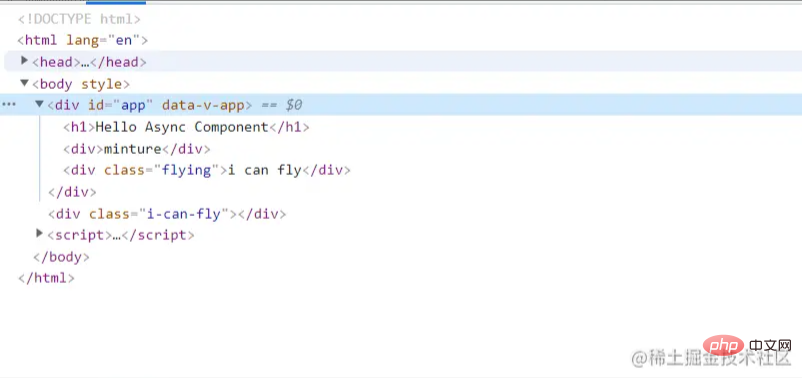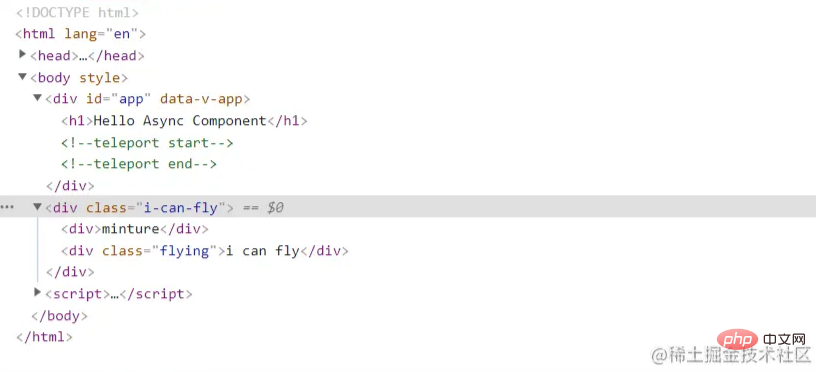快速瞭解Vue3中的Fragment、Suspense、Portal特性

vue3中新增了一些功能來解決vue2中那些戳中開發人員痛楚的詬病。同時,也對vue2中效能進行了優化。本文帶你一起探討vue3中新增的Fragment、Teleport和Suspense的使用方法。
Fragment(碎片化節點)
不知道各位有沒有在vue2中遇到過下圖中的報錯資訊:

這是vue2丟擲的錯誤提示。意思是說元件只能有一個根元素。當我們新建一個vue頁面時,通常會有多個不同的元素節點。我們會在最外層包裹一個div來使其讓它成為這個頁面的根節點。但這並不友好。有時候我們並不需要這個div元素。
vue3中解決了這個問題。vue3中新增了一個類似dom的標籤元素<Fragment></Fragment>。如果在vue頁面中有多個元素節點。那麼編譯時vue會在這些元素節點上新增一個<Fragment></Fragment>標籤。並且該標籤不會出現在dom樹中。

Suspense(非同步元件)
vue3中提供一個<Suspense></Suspense>元件用於控制非同步元件。
//建立一個非同步元件
<script>
const { createApp,defineAsyncComponent } = Vue
const app = createApp({})
const AsyncComp = defineAsyncComponent(
() =>
new Promise((resolve, reject) => {
setTimeout(() => resolve({
template: '<div>I am async!</div>'
}),3000)
})
)
app.component('async-component', AsyncComp)
app.mount('#app')
</script>用Suspense包裹非同步元件 async-component
<Suspense>
<template #default>
<async-component />
</template>
<template #fallback>
Loading ...
</template>
</Suspense>上面的非同步元件使用了定時器,3秒後顯示該元件 我們可以通過defineAsyncComponent提供一系列的引數來定義非同步元件
import { defineAsyncComponent } from 'vue'
const AsyncComp = defineAsyncComponent({
// 工廠函數
loader: () => import('./Foo.vue'),
// 載入非同步元件時要使用的元件
loadingComponent: LoadingComponent,
// 載入失敗時要使用的元件
errorComponent: ErrorComponent,
// 在顯示 loadingComponent 之前的延遲 | 預設值:200(單位 ms)
delay: 200,
// 如果提供了 timeout ,並且載入元件的時間超過了設定值,將顯示錯誤元件
// 預設值:Infinity(即永不超時,單位 ms)
timeout: 3000,
// 定義元件是否可掛起 | 預設值:true
suspensible: false,
/**
*
* @param {*} error 錯誤資訊物件
* @param {*} retry 一個函數,用於指示當 promise 載入器 reject 時,載入器是否應該重試
* @param {*} fail 一個函數,指示載入程式結束退出
* @param {*} attempts 允許的最大重試次數
*/
onError(error, retry, fail, attempts) {
if (error.message.match(/fetch/) && attempts <= 3) {
// 請求發生錯誤時重試,最多可嘗試 3 次
retry()
} else {
// 注意,retry/fail 就像 promise 的 resolve/reject 一樣:
// 必須呼叫其中一個才能繼續錯誤處理。
fail()
}
}
})當設定項中的suspensible為true時,被Suspense包裹的非同步元件將會被控制
Portal(傳送門)
在vue2中我們可能會使用例如element-ui,iview等元件庫,有時候我們會發現這些ui元件庫中的某些元件渲染層級並不包含在vue dom中。如 modal toast等元件的層級就在vue dom 之外。這種在vue之外的層級方便我們進行全域性處理和管理。vue3中提供一對<teleport ></teleport>用於移動dom的層級
<div id="app">
<h1>Hello Async Component</h1>
<com-a />
</div>
<div class="i-can-fly"></div>
// 元件a
const { createApp } = Vue
const componentA = {
template: `<com-b><com-b/><div class="i-can-fly">我能瞬間移動</div>`
}
const componentB ={
template: `<div class="i-can-fly">我能飛</div>`
}
const app = createApp({})
app.component('com-b',componentB)
app.component('com-a',componentA)
app.mount('#app')此時我們開啟控制檯檢視元素

渲染的結果如下。然後我們修改程式碼新增teleport標籤
<div id="app">
<----...--->
<teleport to=".i-can-fly">
<com-a />
</teleport>
</div>
<div class="i-can-fly"></div>此時我們發現元件B已經不在app中了。而是出現在了以類選擇器為i-can-fly的div中。

值得注意的是 teleport標籤上的to參數列示要將包裹的內容所移動到的位置。
【相關推薦:】
以上就是快速瞭解Vue3中的Fragment、Suspense、Portal特性的詳細內容,更多請關注TW511.COM其它相關文章!